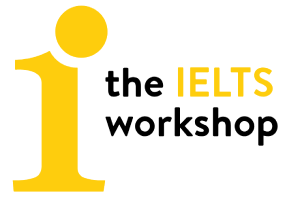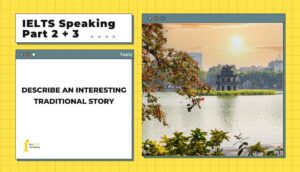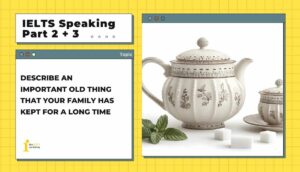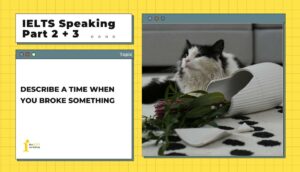Chủ đề Describe a website that sells second-hand items trong IELTS Speaking Part 2 yêu cầu bạn giới thiệu một trang web mua bán đồ cũ và lý do nó hữu ích. Bài mẫu từ thầy Nguyễn Tuấn Ngọc sẽ gợi ý cách triển khai ý tưởng rõ ràng, giúp bạn tự tin hơn khi trả lời.
Part 2: Describe a website that sells second-hand items
You should say
- What it is ?
- How you found out about it ?
- What people can buy from it ?
- And explain whether you like it ?
1. Bài mẫu (Sample)
Well, to be honest, I don’t know many websites that specialize in selling second-hand items here in Vietnam. I suppose they are not as widespread as in other countries, where thrift shops and online reselling platforms are much more established. Of course, it’s still quite common for us to buy pre-owned goods, particularly high-value items such as cars or furniture. In fact, the second-hand markets for cars and motorbikes are enormous, since not everyone can afford a brand-new car here, where the price of even a modest vehicle can amount to several years’ salary. However, for some reason, most of these transactions still take place in traditional, offline markets rather than on digital platforms.
I guess the biggest obstacle for online marketplaces is trust. Actually, speaking of cars, I just remembered one website that dealt with used automobiles, though I can’t recall its exact name. I logged into it a few years ago when my father wanted to sell his car. It was really useful because I could check the resale value of similar models. Unlike new cars, which are sold at fixed retail prices, the value of a second-hand vehicle varies considerably depending on factors like mileage, model, condition, and usage history. Without that knowledge, you might risk selling it for far below its worth or overpricing it and failing to attract buyers. Thanks to the website, we managed to sell my father’s car for slightly above the average market price.
So overall, while online platforms for used items are not yet mainstream in Vietnam, I think they will eventually gain popularity once people place more trust in digital transactions. After all, buying and selling second-hand goods online is far more convenient and transparent, and I believe it’s just a matter of time before more people here adopt it.
Sample by Nguyen Tuan Ngoc, IELTS Teacher at The IELTS Workshop
2. Từ vựng (Vocabulary)
- specialize in: chuyên về
- second-hand items: đồ cũ, đồ đã qua sử dụng
- widespread: phổ biến, rộng rãi
- thrift shops: cửa hàng đồ cũ, tiết kiệm
- reselling platforms: nền tảng bán lại (hàng hóa)
- pre-owned goods: hàng đã qua sử dụng
- high-value items: đồ giá trị cao
- enormous: rất lớn, khổng lồ
- transactions: giao dịch
- obstacle: trở ngại
- resale value: giá trị bán lại
- fixed retail prices: giá bán lẻ cố định
- varies considerably: thay đổi đáng kể
- usage history: lịch sử sử dụng
- mainstream: phổ biến, chính thống
Xem thêm: Cách học từ vựng IELTS hiệu quả từ thầy Đặng Trần Tùng 9.0

Part 3:
1. How do people in your country recycle various items they don’t want?
Well, I have to admit that I don’t often see Vietnamese people actively recycling things themselves. Most typically, people gather used tin cans, plastic bottles, or old newspapers and resell them to recycling companies. For the most part, though, people simply discard used items, since it’s relatively cheap and convenient to just replace them with brand-new ones.
- recycling: tái chế
- resell: bán lại
- discard: vứt bỏ
- brand-new: hoàn toàn mới
2. Do you think it is important to recycle?
Yes, I would say it’s extremely important. Recycling helps reduce the amount of waste going to landfills, which can minimize pollution and protect the environment. It also saves natural resources, since materials like glass, paper, or metal can be reprocessed and used again. Without recycling, we would consume resources at an unsustainable rate, and future generations would definitely suffer.
- unsustainable: không bền vững
- important: quan trọng
- recycling: tái chế
- waste: rác thải
- pollution: ô nhiễm
- environment: môi trường
- natural resources: tài nguyên thiên nhiên
- reprocessed: tái xử lý
3. What do you think governments can do to encourage recycling?
In my opinion, governments should focus on raising public awareness through education campaigns, so people can better understand the long-term benefits of recycling. Apart from that, providing more facilities such as recycling bins in public places would make it easier for citizens to participate. Finally, offering incentives like discounts on utility bills or small tax reductions could be an effective way to motivate people to recycle regularly.
- awareness: nhận thức
- recycling: tái chế
- facilities: cơ sở vật chất
- incentives: ưu đãi, khuyến khích
- motivate: thúc đẩy
4. Why do people buy second-hand clothes?
I suppose one major reason is that you can discover truly unique pieces that are almost impossible to find in ordinary stores. In thrift shops, people often come across vintage items or rare designs from niche brands that really stand out from the mass-produced clothing sold in shopping malls.
Another big factor is, of course, affordability. Branded clothes can be thrifted at a fraction of the original price, which is a real bargain for people on a tight budget, especially students.
- unique pieces: món đồ độc nhất, hiếm có
- thrift shops: cửa hàng đồ cũ / đồ second-hand
- vintage items: đồ cổ điển, đồ xưa cũ
- niche brands: thương hiệu ngách, ít phổ biến
- mass-produced: sản xuất hàng loạt
- affordability: khả năng chi trả
- thrifted: mua đồ cũ / đồ second-hand
- bargain: món hời
- tight budget: ngân sách eo hẹp
5. What do people do with the clothes they don’t want anymore?
Well, unfortunately, most people just throw them away. Clothing has become so cheap and accessible that many people refresh their wardrobes every season. A portion of second-hand clothes is donated to charity, but I’d argue that even people living in remote communities nowadays have no shortage of clothes.
On top of that, with the dominance of fast fashion, garments are designed with aesthetics in mind rather than durability, so they wear out very quickly. Clothes that have been worn for only a year or two are often no longer in good condition. This is disastrous for the environment, because most clothing today is made from synthetic fibers, which pollute soil and water and take centuries to break down.
- throw away: vứt đi
- cheap and accessible: rẻ và dễ mua được
- refresh their wardrobes: thay mới tủ quần áo
- second-hand clothes: quần áo cũ
- donate to charity: quyên góp cho từ thiện
- remote communities: cộng đồng vùng xa
- fast fashion: thời trang nhanh
- garment: quần áo (cách nói trang trọng hơn “clothes”)
- aesthetics: tính thẩm mỹ
- durability: độ bền
- wear out: hao mòn, sờn cũ
- disastrous: gây hại nghiêm trọng
- synthetic fibers: sợi tổng hợp
- pollute: gây ô nhiễm
- break down: phân hủy
6. Some people think it’s a waste to buy too many clothes for children. What do you think?
As the father of a little girl, I’d have to say I completely agree. My parents actually warned me about this when my daughter was born a few years back. At the time, I didn’t take it seriously because, as a first-time parent—and someone who enjoys fashion myself—I was over the moon and found it impossible to resist buying those adorable miniature outfits.
But in reality, many of them were worn once or twice and then ended up being sold or given away. Kids outgrow clothes incredibly fast, some outfits are impractical, and others are made from materials that aren’t gentle on their skin. In the end, only a handful of items were comfortable, practical, and durable enough to be worn regularly.
So, if I were to give advice, I’d say: of course, it’s perfectly fine to buy your beloved child some cute outfits, but try to keep your spending under control. Prioritise quality and practicality over appearance, and buy a few versatile pieces rather than splurging on too many.
- warned me: cảnh báo tôi
- first-time parent: phụ huynh lần đầu
- over the moon: cực kỳ hạnh phúc
- adorable miniature outfits: bộ đồ nhỏ xíu dễ thương
- sold or given away: bán lại hoặc cho đi
- outgrow clothes: lớn nhanh, mặc không vừa quần áo nữa
- impractical: không thực tế
- gentle on their skin: dịu nhẹ với da
- handful of items: chỉ một vài món
- comfortable, practical, and durable: thoải mái, thực tế và bền
- spending under control: kiểm soát chi tiêu
- prioritise quality and practicality: ưu tiên chất lượng và tính thực tiễn
- versatile pieces: những món đồ đa năng
- splurging: vung tiền mua sắm quá mức
Sample by Nguyen Tuan Ngoc, IELTS Teacher at The IELTS Workshop
Từ vựng mở rộng theo chủ đề
- pre-owned / previously owned: đã qua sử dụng
- hand-me-downs: quần áo được truyền lại từ anh/chị/em trong gia đình
- worn-out: sờn, cũ, hỏng
- in mint condition: gần như mới, còn rất tốt
- retro / vintage: phong cách cổ điển
- limited edition: phiên bản giới hạn
- thrift shopping: đi mua đồ second-hand
- swap markets: chợ trao đổi quần áo
- upcycle: tái chế thành sản phẩm có giá trị mới
- sustainable fashion: thời trang bền vững
- reduce textile waste: giảm rác thải vải vóc
- carbon footprint: lượng khí thải carbon
Xem thêm: Tổng hợp 30+ chủ đề từ vựng IELTS thông dụng mà bạn cần biết
Tạm kết
Hy vọng bài mẫu trên đã giúp bạn hình dung rõ cách triển khai ý tưởng và sử dụng ngôn ngữ phù hợp khi gặp chủ đề Describe a website that sells second-hand items trong IELTS Speaking Part 2 & 3.
Để nâng cao phản xạ và làm giàu vốn từ, bạn nên luyện thêm nhiều chủ đề đa dạng, với các nguồn tài liệu hữu ích như KHO BÀI MẪU IELTS SPEAKING và Bộ đề dự đoán IELTS Speaking cập nhật mới nhất.
Đăng ký ngay lớp HỌC IELTS MIỄN PHÍ chỉ có trên website của The IELTS Workshop để bắt đầu lộ trình học bài bản cùng thầy cô tại TIW nhé !









